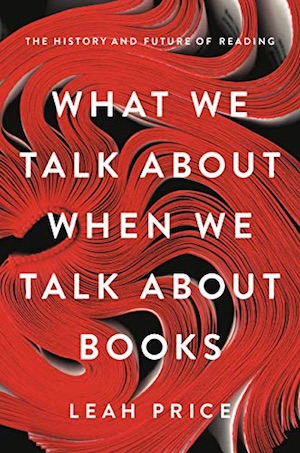Winner of the 2020 Christian Gauss Award
By Suzanne Keen
Chin-Yee Lai designed a gorgeous, dynamic cover for Leah Price’s book, What We Talk About When We Talk About Books. With a sideways angle on the top of the red-dyed edge of a splayed softcover volume, the cover image looks like a flower, or an abstract octopus, or three cartoon acrobats tumbling upwards in scarlet bell-bottoms. Judge a book by its cover? Damn straight I will. This is a quality book, printed on creamy stock in a generous layout with plenty of white space. Sorry—I’m not a font nerd—but the book is printed in one of those classy fonts with serifs, maybe Garamond? In fact, I would have liked this book just one iteration better if it had the little info-page about the font and its history, tucked in right before the flecky endpapers. Leah Price really should have insisted on the inclusion of its precise place of printing, such as Harrisonburg, Virginia, not just the United States of America. (I really get a kick out of knowing where the actual physical book in my hand was printed and bound and boxed up and shipped—sometimes across the Atlantic Ocean to become a British first-edition after its origin in the Shenandoah Valley.)
As it happens, I also read this book. The quality of the volume made me feel a teensy twinge when I bent the pages down to tab places for reference, but I remember Leah Price when she was a student: no one could sticky-tab, annotate, flip through at high-speed, and put a physical book through its paces like she could. Make no mistake: she’s a wide and deep reader, but her subject in What We Talk About When We Talk About Books isn’t the content of books so much as The History and Future of Reading. Has some fundamental relationship between books and readers been disrupted by ebooks and screen-reading? (No, not really.) How has book-reading (especially fiction reading) morphed from a suspect activity of the indolent into an improving, character-reforming antidote to crime, vice, poverty, and mental illness? Why do we attribute powers to inanimate objects—books—without recalling the influential people who teach us to read them and press them into our hands? What’s going on when rare books are valuable collectibles and ordinary books can be lent or handed on, but the words displayed on your e-reader could vanish if a publisher rescinded electronic distribution rights? Price tackles these and dozens of other fascinating questions about books, readers, reading, publishing, and (her academic subject) the history of the book, in lively, even aphoristic prose.
In the process of touring such a varied terrain, Price reminds us of many of the conventions of books and reading that often remain invisible to us. That’s a major part of the fun of this book. At just about the sovereign midpoint of the volume, she lays bare one of the devices of the codex to which we have become so accustomed that we fail to notice it. In English, literate people read from left to right and top to bottom, our eyes zigging back to the left margin when we hit the gutter (when reading the left page), blithely ignoring the consumed material on the other side of the gutter when we read the right page. (Why do we do that?) Under a headline that stretches across the whole ten inches or so, “INTERLEAF: PLEASE LAY FLAT,” Price breaks into memoir, in an episode about her body’s rejection of the usual seated reading posture. A spinal injury made sitting excruciating and standing and lying flat the alternatives for reading. In these pages, the reader must proceed from the far left all the way to the right-hand edge of the book, rather than performing our usual visual u-turn at the gutter. This section would have worked better for reading flow if the binding had more neatly aligned the left and right pages. . . unless that little discomforting jig to find the right place to pick up after leaping the gutter was intentional. . . oh wait. Well, it sure slowed me down. And, like Price when cured by a regimen of abdominal curls, I was glad to revert to reading normally when it was over.
Suzanne Keen (ΦBK, Brown University) serves as Vice President of Academic Affairs and Dean of Faculty at Hamilton College, where she is also Professor of Literature. She works on the novel and narrative empathy.




